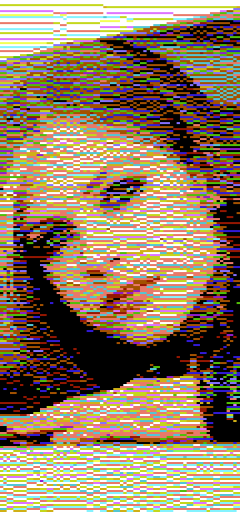


These are three different pics in a 72x256 pixel graphics mode with 8x1 color resolution in Hires (or 4x1 in Multicolor) with freely chooseable border, background and multicolor-auxiliary color per line working on a PAL-VIC with at least 16K expansion.
You can also try this with some more pics in VICE or on a real VIC by downloading this package:
FLI-mode demonstration (not safe for work)
Why "not safe for work"? Well
To get this working you will have to copy the four files bitmap.prg, colour.bin, 900e.bin and 900f.bin from one of the subdirectories to the main directory. Then just drag and drop boot.prg into your VICE window - making sure it's set to at least 16K expansion - and let it do it's magic (or just go to Warp Mode by pressing ALT+W to speed things up). Et voila!
Huge thanks go to Mike for creating the conversion program to create those images. It is included with the package called fli_quant.exe - it expects a file called 'input.ppm' with a resolution of exactly 72x256 pxiels (24-Bit-RGB) and will create a file result.ppm and the 4 files to be used by the VIC mentioned before.
How does this graphics mode work?
Some weeks ago after finishing the MAXIGRAFIK-mode I had a new idea: Why not use the processor-time that's used to create a larger bitmap to create a better color resolution? tlr's FCBPAINT already uses some neat tricks to increase color resolution, like switching the color-RAM between $9400 and $9600 every 4 lines and being able to switch the border & background color ($900f) and multicolor-auxiliary color ($900e) each line or even within a line.
My idea combines this with on-the-fly color-ram updates by always writing color information for the next line while displaying the current one. I'm heavily limited by the number of bytes that can be updated per line because a raster line only has 71 cycles in PAL and updating one byte takes at least 6 cycles and I also want to be able to switch $900f and $900e in each line. Plus another 4 cycles are needed to switch the color-RAM after each line. This leads to a maximum line width of 72 pixel. Here's the math:
72 pixels = 9 byte = 54 cycles to update
$900e, $900f = 2 byte = 12 cycles to update
$9005 update = 1 byte = 6 cycles to update (4 cycles if using pre-set register to store)
So, one line takes 72 cycles to update and switch and the next one 70 cycles. Perfect
Comments are welcome as always!

